
Lantern Festival, also called Shangyuan Festival, is celebrated on January 15 of Chinese lunar calendar. It is the first full moon night in the Chinese lunar year, symbolizing the coming back of the spring. Lantern Festival may be regarded as the last day of Spring Festival, the new-year festival of China, in other words, the Spring Festival does not end until the Lantern Festival has passed. Lasting to Lantern Festival, the busy atmosphere of Spring Festival on that day shows new visions and amorous feelings. Lantern Festival is regarded as a good day for family gather-together. According to the folk custom of China, people on that night will lighten up fancy lanterns and go out to appreciate the moon, set off fireworks, guess riddles written on lanterns, and eat rice glue balls to celebrate the festival.
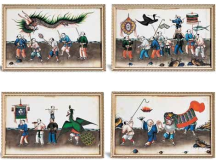
The tradition of appreciating lanterns on the Lantern Festival originates from the Eastern Han Dynasty, which has a bearing on the introduction of Buddhism into China at that time. It is a Buddhist convention that the monks would visit Buddhist relics and lighten up lanterns to show respect to Buddha on Jan. 15. Therefore, Emperors of that dynasty, who were determined to promote Buddhism, ordered people to lighten up lanterns in both palaces and temples on that night to show respect to Buddha. Additionally, civilians were all requested to hang up lanterns on that night, which is why the festival is called “Lantern Festival”. In the Song Dynasty, the custom of guessing riddles written on lanterns on Lantern Festival came into being and people at that time wrote riddles on paper strips and then pasted them on the colorful lanterns for others to appreciate and guess. In the Qing Dynasty, fireworks were set off to add fun, and the Lantern Festival by then witnessed a record-breaking grand occasion.
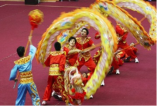
The traditional dim sum eaten on Lantern Festival is called “yuanxiao” (rice glue ball) or commonly called “tangyuan”. A meaning of family reunion and happiness may be felt even only from such name. Yuanxiao has its appearance made into a ball shape and white sugar, sweetened bean paste, sesame as the stuffing. Besides, walnut meat, nuts, and even meat can be used as the stuffing as well. Apart from the boiling manner, yuanxiao may also be prepared through deep frying and steaming manners.
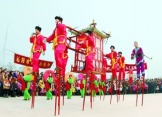
As time goes by, the Lantern Festival has enjoyed more and more celebrating activities. Some places even add traditional folk-custom performances such as playing dragon lantern, Lion Dancing, stilting, striking land boat, doing the Yangko, and striking Peace Drum. The Lantern Festival, a traditional Chinese festival which has experienced a history of over 2,000 years, is still very popular both at home and abroad, and any place where Chinese people live will witness a busy occasion on that day.
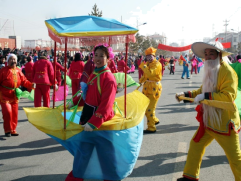
During the Lantern Festival, Valentine’s young men and women meet with the timing, the Lantern Festival and become China’s “Valentine’s Day.” (491 words)
1. According to the folk custom of China, what will people do on the night of the Lantern Festival?2. How did the custom of appreciating lanterns on the Lantern Festival come into being?
3. Do you know how to prepare yuanxiao? Tell your friends how to prepare it.
4. What kind of celebrating activities will be held in celebration the Lantern Festival?
5. Guess lantern riddles
(1). What has a mouth and a fork but never eats?
(2) What has a hand but can’t scratch itself?
(3). What has no skin or bones, yet has four fingers and a thumb?
(4). What part of a watch was used before by someone else?
(5). Why is an empty purse always the same?
(6). What is something that never asks any questions but demands a great many answers?

The Double Ninth Festival, also named Chong Yang Festival, falls on the ninth day of the ninth month of the Chinese lunar calendar, hence it gets name of Double Ninth Festival. On this day, people would like to drink chrysanthemum wine and have chrysanthemum cakes.
The chrysanthemum is a plant often used as a Chinese herbal medicine. People in ancient times believed that, in addition to detoxification, chrysanthemum could drive away evil spirits and prevent one from getting a cold in late autumn. So, making and drinking chrysanthemum could date back to many centuries, and it became the traditional food on the Double Ninth Festival, to avoid evil spirits and misfortunes. Besides, the Chinese word for wine is Jiu, a homonym of the Chinese word for long, symbolizing longevity.

Another special food for this festival is chrysanthemum cakes. The Chinese word for cake is Gao, a homonym of the Chinese word for high, symbolizing progress and promotion at work and in daily life and improvement in life year by year. In addition, mountains are high, so eating cakes can take the place of going for a climb -- by a stretch of the imagination.
Since nine is the highest odd digit, people take two of them together to signify longevity. Therefore, the ninth day of the ninth month has become a special day for people to pay their respects to the elderly and a day for the elderly to enjoy themselves. It has also been declared China’s Day for the Elderly.
 Origin
OriginThe festival is based on the theory of Yin and Yang, the two opposing principles in nature. Yin is feminine, negative principle, while Yang is masculine and positive. In ancient times people believed that all natural phenomena could be explained by this theory. Numbers were also related to this theory. Even numbers belonged to Yin and odd numbers to Yang. The ninth day of the ninth lunar month is a day when the two Yang numbers meet. So it is called Chong Yang. Chong means double in Chinese. Chong Yang has been an important festival since ancient times.
 Legend
Legend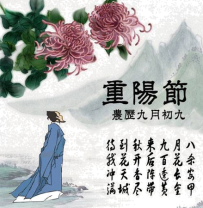
It is hard to say when these customs were created. But there are many stories which are closely related. As recorded in a historical book of the sixth century, in ancient times, there lived a man named Huan Jing. He was learning the magic arts from Fei Changfang, who had become an immortal after many years of practicing Taoism. One day, the two were climbing a mountain. Fei Changfang suddenly stopped and looked very upset. He told Huan Jing, On the ninth day of the ninth lunar month, disaster will come to your hometown. You must go home immediately. Remember to make a red bag for each one of your family members and put a spray of dogwood on every one. Then you must all tie your bags to your arms, leave home quickly and climb to the top of a mountain. Most importantly, you must all drink some chrysanthemum wine. Only by doing so can your family members avoid this disaster.
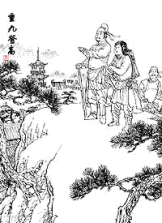
On hearing this, Huan Jing rushed home and asked his family to do exactly as his teacher said. The whole family climbed a nearby mountain and did not return until the evening. When they got back home, they found all their animals dead, including chickens, sheep, dogs and even the ox. Later Huan Jing told Fei Changfang about this. Fei said the poultry and livestock died in place of Huan Jing’s family, who escaped disaster by following his instructions.
Since then, climbing a mountain, carrying a spray of dogwood and drinking chrysanthemum wine became the traditional activities of the Double Ninth Festival, to avoid evil spirits and misfortunes.
 A Day for Outing
A Day for OutingThe festival is held in the golden season of autumn, at harvest-time. The bright clear weather and the joy of bringing in the harvest make for a festive happy atmosphere. The Double Ninth Festival is usually perfect for outdoor activities. Many people go hiking and climbing in the countryside, enjoying Mother Nature’s final burst of color before she puts on her dull winter cloak. Some will carry a spray of dogwood.
Therefore, it is now considered the last outing of the year before the beginning of winter, for people to go climbing to get some exercise as well as enjoy the autumn scenery.
1. Why is Chong Yang Festival called the Double Ninth Festival?2. Why would people like to drink chrysanthemum wine and have chrysanthemum cakes on the Double Ninth Festival?
3. Why is Chong Yang Festival also called China’s Day for the Elderly?
4. Tell your friends the legend of the Double Ninth Festival.
3 . Last week, I sent the same request to ChatGPT, the latest artificial-intelligence chatbot from OpenAI. “Upon the Firth of Forth, a bridge doth stand,” it began. In less than a minute, the program had created in full a rhyming Shakespearean sonnet (莎士比亚十四行诗). Tools like ChatGPT seem poised to change the world of poetry — and so much else — but poets also have a lot to teach us about artificial intelligence. If algorithms (算法) are getting good at writing poetry, it’s partially because poetry was always an algorithmic business.
Even the most rebellious (叛逆的) poets follow more rules than they might like to admit. When schoolchildren are taught to imitate the structure of sonnet, they are effectively learning to follow algorithmic constraints. Should it surprise us that computers can do so, too?
But considering how ChatGPT works, its ability to follow the rules for sonnets seems a little more impressive. No one taught it these rules. It is based on a newer kind of AI known as a large language model (LLM). To put it simply, LLMs analyze large amounts of human writing and learn to predict what the next word in a string of text should be, based on context. One frequent criticism of LLMs is that they do not understand what they write; they just do a great job of guessing the next word.
When a private verse by Dickinson makes us feel like the poet speaks directly to us, we are experiencing the effects of a technology called language. Poems are made of paper and ink — or, these days, electricity and light. There is no one “inside” a Dickinson poem any more than one by ChatGPT. Of course, every Dickinson poem reflects her intention to create meaning. When ChatGPT puts words together, it does not intend anything. Some argue that writings by LLMs therefore have no meaning, only the appearance of it. If I see a cloud in the sky that looks like a giraffe, I recognize it as an accidental similarity. In the same way, this argument goes, we should regard the writings of ChatGPT as merely imitating real language, meaningless and random as cloud shapes.
When I showed my friends the sonnet by ChatGPT, they called it “soulless and barren.” Despite following all the rules for sonnets, the poem is predictable. But is the average sonnet by a human any better? If we now expect computers to write not just poems but good poems, then we have set a much higher bar.
1. What is the main idea of paragraph 1 and paragraph 2?| A.ChatGPT will make a difference to poetry based on algorithms. |
| B.There is no doubt that AI can copy the grammatical rules of poetry. |
| C.Poetry guidelines provide a possibility for AI’s poetry writing. |
| D.There is a similarity between algorithms and poetry. |
| A.ChatGPT is trained to follow the rules by LLMs. |
| B.ChatGPT can analyze and predict human languages. |
| C.ChatGPT is technologically supported by LLMs. |
| D.ChatGPT itself learn to follow the rules. |
| A.He talks about cloud to describe the meaninglessness of AI’s poetry. |
| B.He tells of Dickinson to describe the meaninglessness AI’s poetry. |
| C.He mentions cloud to suggest its close relationship with AI’s poetry. |
| D.He refers to Dickinson to suggest her close relationship with AI’s poetry. |
| A.Acceptable and favorable | B.Amazed and admiring |
| C.Indifferent and uncaring | D.Doubtful and uneasy |
4 . When you ask people to judge others by their speech, a trend emerges: Listeners dislike disfluency. Slow talkers producing loads of ums and pauses(停顿)are generally perceived as less charming. But science tells us there may be even more to disfluency.
Disfluencies do not occur in arbitrary positions in sentences. Ums typically occur right before more difficult or low-frequency words. Imagine you’re having dinner with a friend at a restaurant,and there’re three items on the table: a knife, a glass, and a wine decanter(醒酒器). Your friend turns to you and says, “Could you hand me the...um...” What would you assume they want? Since it’s unlikely that they will hesitate before such common words as knife, and glass, chances are you’ll pick up the decanter and ask, “You mean this?”
This is exactly what we demonstrated through controlled eye-tracking studies in our lab. Apparently, listeners hear the um and predict that an uncommon word is most likely to follow.Such predictions, though, reflect more than just simple association between disfluencies and difficult words; listeners are actively considering from the speaker’s point of view. For example, when hearing a non-native speaker say the same sentence but with a thick foreign accent, listeners don’t show a preference for looking at low-frequency objects. This is probably because listeners assume non-native speakers may have as much trouble coming up with the English word for a common object, like a knife, as for unusual ones and can’t guess their intention.
In another experiment, listeners were presented with an atypical speaker who produced disfluencies before simple words and never before difficult words. Initially, participants displayed the natural predictive strategy: looking at uncommon objects. However, as more time went by, and they gained experience with this atypical distribution of disfluencies, listeners started to demonstrate the contrary predictive behavior: They tended to look at simple objects when hearing the speaker say um.
These findings represent further evidence that the human brain is a prediction machine: We continuously try to predict what will happen next, even though not all disfluencies are created equal.
1. What does the underlined word “arbitrary”mean in paragraph 2?| A.Random. | B.Strategic. | C.Obvious. | D.Consistent |
| A.They can be understood easily. | B.They actively put themselves in others’ shoes |
| C.Their vocabularies are limited. | D.Their disfluencies are a little less predictive. |
| A.Simple things are difficult in some cases. | B.Listeners can adjust predictions accordingly. |
| C.Distribution of disfluencies is changeable. | D.Disfluencies in communication can be avoided. |
| A.Pauses Coexist with Prediction. | B.Brains Are Powerful Prediction Machines. |
| C.Active Listeners Simplify Talks. | D.Disfluency Says More Than You Think. |
5 . Animal appear to predict earthquakes by sensing electricity in the air — the first study to find reliable evidence of the phenomenon has shown.
Cameras revealed an “amazing” drop in the number of animals up to 23 days before a major quake hit their rainforest home at Yanachaga National Park in Peru. Lead scientist Dr Rachel Grant, from Anglia Ruskin University, said, “The results showed that just before the earthquake, animals’ activity dropped right down.”
On a normal day the cameras placed around Yanachaga National Park record between 5 and 15 animals. But in the 23 days before the earthquake, the number of animals dropped to five or fewer per day. No animals were photographed at all on five of the seven days immediately before the quake.
Another study showed that animal activity remained normal in the park over a different period when seismic (地震的) activity was low. Co-author, professor Friedemann Freund, said, “The cameras were located at an altitude of 900 meters. If air ionization occurred, the animals would escape to the valley below, where there were fewer positive ions ( 离子). With their ability to sense their environment, animals can help us understand small changes that occur before major earthquakes.”
Other evidence suggested that before the earthquake, the air around the high mountain sites filled with positive ions that can be produced when rocks are placed under stress. Positive ions have been known to cause ill effects in humans as well as animals. Scientists believe the animals were made to feel uncomfortable by the positive ions, leading them to avoid the area. They are thought to have escaped to lower ground, where the air was less ionized. The findings may help experts develop better short-term seismic forecasts.
1. How did scientists conduct the study?| A.By comparing different animals’ habits. |
| B.By observing animals in high mountains. |
| C.By explaining the positive ion phenomenon. |
| D.By analyzing images of animals they obtained. |
| A.The ground at a lower altitude is less ionized. |
| B.Cameras normally record more animals per day. |
| C.Earthquake warnings can be detected in lower places. |
| D.The activity of animals and earthquakes is consistent. |
| A.The findings make for accurate seismic forecast. |
| B.Animals tend to be uneasy with more positive ions. |
| C.Positive ions make humans and animals depressed. |
| D.All the animals remain abnormal before the earthquake. |
| A.Negative Influence of Positive Ions. |
| B.Ions’ Destruction to the Environment. |
| C.Animals’ Behavior Before Earthquakes. |
| D.Creatures’ Ability to Predict Earthquakes. |
6 . In our information-driven society, shaping our worldview through the media is similar to forming an opinion about someone solely based on a picture of their foot. While the media might not deliberately deceive us, it often fails to provide a comprehensive view of reality.
Consequently, the question arises: Where, then, shall we get our information from if not from the media? Who can we trust? How about experts- people who devote their working lives to understanding their chosen slice of the world? However, even experts can fall prey to the allure of oversimplification, leading to the “single perspective instinct” that hampers (阻碍) our ability to grasp the intricacies (错综复杂) of the world.
Simple ideas can be appealing because they offer a sense of understanding and certainty. And it is easy to take off down a slippery slope, from one attention-grabbing simple idea to a feeling that this idea beautifully explains, or is the beautiful solution for, lots of other things. The world becomes simple that way.
Yet, when we embrace a singular cause or solution for all problems, we risk oversimplifying complex issues. For instance, championing the concept of equality may lead us to view all problems through the lens of inequality and see resource distribution as the sole panacea. However, such rigidity prevents us from seeing the multidimensional nature of challenges and hinders true comprehension of reality. This “single perspective instinct” ultimately clouds our judgment and restricts our capacity to tackle complex issues effectively. Being always in favor of or always against any particular idea makes you blind to information that doesn’t fit your perspective. This is usually a bad approach if you would like to understand reality.
Instead, constantly test your favorite ideas for weaknesses. Be humble about the extent of your expertise. Be curious about new information that doesn’t fit, and information from other fields. And rather than talking only to people who agree with you, or collecting examples that fit your ideas, consult people who contradict you, disagree with you, and put forward different ideas as a great resource for understanding the world. If this means you don’t have time to form so may opinions, so what?
Wouldn’t you rather have few opinions that are right than many that are wrong?
1. What does the underlined word “allure” in Para.2 probably mean?| A.Temptation. | B.Tradition. | C.Convenience. | D.Consequence. |
| A.They meet people’s demand for high efficiency. |
| B.They generate a sense of complete understanding. |
| C.They are raised and supported by multiple experts. |
| D.They reflect the opinions of like-minded individuals. |
| A.Simplifying matters releases energy for human brains. |
| B.Constant tests on our ideas help make up for our weakness. |
| C.A well-founded opinion counts more than many shallow ones. |
| D.People who disagree with us often have comprehensive views. |
| A.Embracing Disagreement: Refusing Overcomplexity |
| B.Simplifying Information: Enhancing Comprehension |
| C.Understanding Differences: Establishing Relationships |
| D.Navigating Complexity: Challenging Oversimplification |
7 . Armed with a toolkit of techniques and tricks to calm the mind and bring focus back to your body, you can stop stressful situations from sabotaging your day, says Katy Georgiou.
GROUND YOURSELF
Making contact with the ground is your baseline go-to response for stress. This technique can be especially helpful if you find your stress regularly turns into panic. Wherever you are, whatever you’re doing, place your feet flat on the ground so that you feel stable, and then close your eyes. If you’re able to sit on the floor cross-legged or to lie down flat, then even better.
Think of this as earthing: really connect with the ground beneath your body. Some studies suggest that this simple act can help reduce or relieve symptoms of stress such as pain and fatigue, reduce blood pressure, and improve sleep. If you’re feeling disconnected from the world, it can also remind you that you belong to it and are a crucial part of it — the ground will always be there for you.
LOVE THYSELF
Adopting regular, daily or weekly routines for self-care can be very containing, creating consistency amid all sorts of stressful life events happening around you. Looking in the mirror each day can actually remind you that you exist, so feel free to factor some reflective gazing into your daily routine, whether it’s while applying moisturiser, shaving, or brushing your hair. Studies have shown that being confronted with your reflection can have powerful effects, taking us out of our heads and into the immediate present. For added effect, pay attention to the way your products interact with your hair and skin as you apply them.
Playing around with smells, colours and textures in your hands will also engage your senses. Using a scented shampoo or smoothing on body lotion after a warm bath can be easy ways to do this.
CLEAR YOUR MIND
Abandon all your thoughts and try to focus only on your surroundings. What can you see, hear, smell, taste and touch? Identify three things you can hear, one thing you can taste, four things you can see and two things you can feel on your skin. Pick out colours in the room you are sitting in, notice textures and different kinds of light. If somebody is with you, tell them what you are experiencing. The point here is that your senses are your best and easiest route back to feeling calm, by coming out of your head and rooting yourself back in the present. This is incredibly helpful if you’re having a panic attack or flop response.
1. If your friend Jane always feels worn out and suffers from sleep deprivation, which of the following techniques will you especially recommend to her?| A.Connect her body to the ground beneath her. |
| B.Adopt a daily gaze at her reflection in the mirror. |
| C.Exchange her scentless shampoo for an aromatic one. |
| D.Focus on what she can see, hear, smell, taste and touch. |
| A.Lying down flat can better relieve your stress. |
| B.Grounding yourself can give you a sense of belonging to the world. |
| C.Brushing your hair while looking in the mirror can remind you of your existence. |
| D.Those having a panic attack should shut their senses down. |
| A.help people understand themselves better |
| B.introduce some practical methods for stress management |
| C.emphasize the significance of exploiting multiple senses |
| D.promote a mindset of living in the moment |
8 . How Did You Get Five Fingers?
Your arms and toes began as tiny buds that sprouted from your sides when you were just a four-week-old embryo (胚胎). By six weeks, these limb buds had grown longer and five rods of cartilage 软骨) had appeared in their flattened tips. By week seven, the cells between the rods had died away, forming five small fingers or toes from once-solid masses of flesh.
Now, a team of scientists led by James Sharpe from the Centre for Genomic Regulation in Barcelona has discovered that these events are carefully orchestrated by three molecules. They mark out zones in the embryonic hand where fingers will grow, and the spaces in between that are destined to die. Without such molecules, pianos and keyboards wouldn’t exist, and jazz hands would be jazz palms.
These three molecules work in a way first envisioned by Alan Turing, a legendary English mathematician and code-breaker. Back in 1952, Turing proposed a simple mathematical model in which two molecules could create patterns by spreading through tissues and interacting with each other. For example, the first molecule might activate the second, while the second blocks the first. Neither receives any guidance about where to go; through their dance, they spontaneously organize themselves into spots or stripes.
Since then, many scientists have found that these Turing mechanisms exist. They’re responsible for a cheetah’s spots and a zebrafish’s stripes. For 30 years, people have also suggested that they could sculpt our hands and feet, but no one had found the exact molecules involved.
Sharpe knew that these molecules would need to show a striped pattern. Sox9 seemed like the most promising candidate. It is activated in a striped pattern from a very early stage of development. By comparing cells where Sox9 is active or inactive, Jelena Raspopovic and Luciano Marcon found two other groups of genes—Bmp and Wnt—also formed striped patterns. Bmp rises and falls in step with Sox9 and both are active in the digits. Wnt is out of phase; it’s active in the gaps. The three molecules also affect each other: Bmp activates Sox9 while Wnt blocks it; and Sox9 blocks both of its partners. It looked like these were the molecules the team was searching for not a pair, as Turing suggested, but a trinity. To confirm this, they created a simulation of a growing limb bud and showed that Sox9, Bmp and Wnt could organize themselves into a pattern of five stripes, by activating and blocking each other.
There’s still a lot to discover, though. For example, I’ve used Bmp and Wnt as shorthands here—in reality, each represents a class of several molecules, and the team still needs to work out which specific member is part of the Turing’s proposal.
1. The underlined sentence in the second paragraph means that ________.| A.some certain molecules are necessary for the growth of human fingers |
| B.the development of embryos is dependent on some certain molecules |
| C.without some certain molecules, music won’t exist in this world |
| D.the molecules work in a way that Alan Turing once offered |
| A.Molecules interact by following a strict mathematical model. |
| B.Molecules have a strong will to form patterns in nature. |
| C.The formation of patterns in nature may be dominated by molecules. |
| D.Alan Turing was able to track down the movement of molecules. |
| A.A protein that determines humans’ development in childhood. |
| B.A gene especially important for the development of our limbs. |
| C.A striped pattern that always interacts with Bmp and Wnt. |
| D.A simulation of growing limbs that activate and block each other. |
| A.How human limbs are developed may well be similar to how animal spots are shaped. |
| B.The way Sox9 interacts with Bmp and Wnt is still a mystery that needs further studying. |
| C.Sox9 can activate both Bmp and Wnt to form our limbs, according to scientific research. |
| D.Sox9, Bmp and Wnt are three specific molecules that determine the growth of fingers. |
9 . On March 7, 1907, the English statistician Francis Galton published a paper which illustrated what has come to be known as the “wisdom of crowds” effect. The experiment of estimation he conducted showed that in some cases, the average of a large number of independent estimates could be quite accurate.
This effect capitalizes on the fact that when people make errors, those errors aren’t always the same. Some people will tend to overestimate, and some to underestimate. When enough of these errors are averaged together, they cancel each other out, resulting in a more accurate estimate. If people are similar and tend to make the same errors, then their errors won’t cancel each other out. In more technical terms, the wisdom of crowds requires that people’s estimates be independent. If for whatever reasons, people’s errors become correlated or dependent, the accuracy of the estimate will go down.
But a new study led by Joaquin Navajas offered an interesting twist (转折) on this classic phenomenon. The key finding of the study was that when crowds were further divided into smaller groups that were allowed to have a discussion, the averages from these groups were more accurate than those from an equal number of independent individuals. For instance, the average obtained from the estimates of four discussion groups of five was significantly more accurate than the average obtained from 20 independent individuals.
In a follow-up study with 100 university students, the researchers tried to get a better sense of what the group members actually did in their discussion. Did they tend to go with those most confident about their estimates? Did they follow those least willing to change their minds? This happened some of the time, but it wasn’t the dominant response. Most frequently, the groups reported that they “shared arguments and reasoned together”. Somehow, these arguments and reasoning resulted in a global reduction in error. Although the studies led by Navajas have limitations and many questions remain, the potential implications for group discussion and decision-making are enormous.
1. What is paragraph 2 of the text mainly about?| A.The methods of estimation. | B.The underlying logic of the effect. |
| C.The causes of people’s errors. | D.The design of Galton’s experiment. |
| A.the crowds were relatively small | B.there were occasional underestimates |
| C.individuals did not communicate | D.estimates were not fully independent |
| A.The size of the groups. | B.The dominant members. |
| C.The discussion process. | D.The individual estimates. |
| A.Unclear. | B.Dismissive. | C.Doubtful. | D.Approving. |
10 . The next time San Francisco residents stop a taxi, they may step into a car with no one behind the wheel. Driverless taxis are now allowed to come on the city’s streets. On June 2, 2022, Cruise, a division of General Motors (GM), was approved to charge for rides in its self-driving cars, becoming the first company allowed to operate commercial driverless cars in a major US city.
Though Cruise is regarding it as a big win, its self-driving cars aren’t totally free to run on the streets of San Francisco as they please. Cruise vehicles will be limited to transporting passengers in less crowded areas of the city between 10 p.m. and 6 a.m. The speed limit is 30 mph. They are also not allowed to operate in heavy rain or fog. The rules are meant to reduce any injuries or accidents.
Cruise plans to launch the service gradually with a team of just 30 cars. The first robotaxis will be improved versions of GM’s Chevrolet Bolt. However, the company is seeking approval to get its custom-built Cruise Origin on public roads. The driverless electric vehicle has no wheels or pedals (踏板) and can attain highway speeds. The car consists mostly of a siting space, where passengers can face each other.
Cruise’s ability to obtain the commercial permit to operate is a big step forward. However, the company still has to convince passengers that its technology is safe. Many remain concerned about safety. A 2021 survey by the American Automobile Association found that 74 percent of Americans are afraid to ride in a self-driving vehicle.
It remains to be seen how the new driverless taxi experiment will play out in San Francisco. But based on the vast number of companies that are racing to develop self-driving vehicles and the tens of thousands of people on waitlists for robotaxi rides, the Cruise pioneering program is at least set for popularity, if not success.
1. What can we learn about the Cruise’s driverless ride services?| A.The services have turned out to be a great success. |
| B.The services receive great support from the public. |
| C.The services have run in some major cities of the USA. |
| D.The services are limited to some regions of San Francisco. |
| A.The feature of Cruise Origin. |
| B.The future of self-driving cars. |
| C.The original plan of the company. |
| D.The new version of Chevrolet Bolt. |
| A.Doubtful. | B.Opposed. |
| C.Favourable. | D.Unconcerned. |
| A.Cruise Offers Free Self-driving Ride Services |
| B.Self-driving Cars Are Coming to San Francisco |
| C.Self-driving Vehicles Are Popular in Major Cities |
| D.Companies Begin to Charge for Rides in Self-driving Cars |



